To Jean-Michel Frodon
Twofold always. May God us keep
From single vision and Newton’s sleep.
William Blake
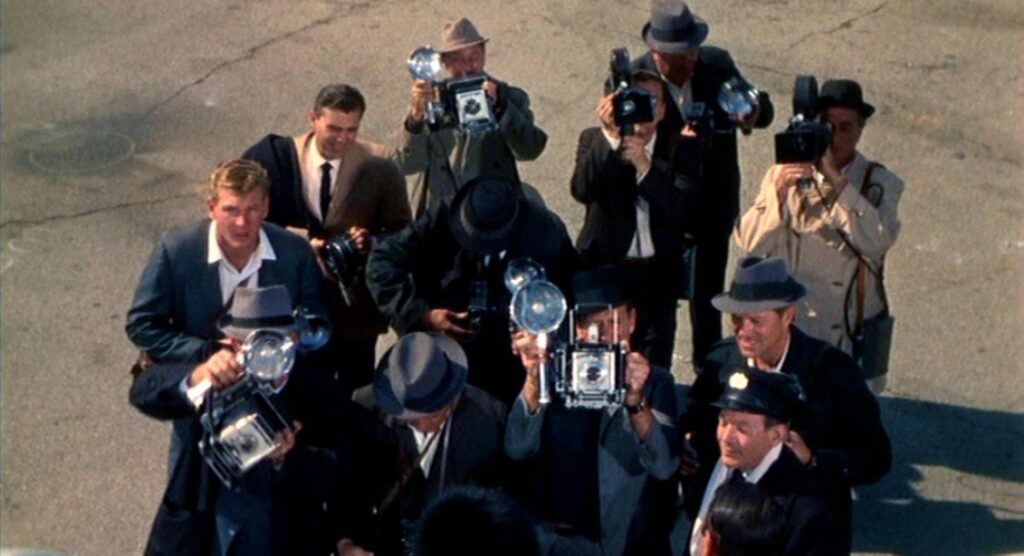
The challenges of quotation befall all of us, even at the most casual level, as when, recounting to some chum a conversation we had yesterday we easily put someone else’s words into present usage, and our own past words along with them. Scholars quote as though by nature, formally “borrowing” from earlier text and placing in refreshing new contexts. Courtrooms are filled with witnesses who give sworn testimony as to what somebody once told them somewhere else, a long time ago. Newspapers make the “news” they sell by taking words out of context and re-setting them, sometimes with frightening inaccuracy, whatever “accuracy” can be claimed to be. Filmmakers quote, too.
Without stepping into the province of intertextuality, in which thematic strands from one work are explored as influences of, or mirrors of, thematic strands in another, I am interested in the problem posed when a filmmaker literally lifts a scenic moment for a present use distinct from the original purposes. A set-up, a movement, a bit of dialogue, a camera placement, an exact turn of events. In La Furia I earlier noted some relevant echoing between Jean-Luc Godard’s Nouvelle vague (1990) and Joseph L. Mankiewicz’s The Barefoot Contessa (1954), a film with which Godard would have been on quite familiar terms. I think we generally tend to presume, when we see a filmic quotation, that the current filmmaker is notably familiar with the work quoted, familiar even exceptionally, whereas this may well not be true. But quite differently from what can happen with intertextuality, when we see what we take to be “quotation” we find relations and relevances that are distinct, sharply bounded, easily evident to the eye and ear, and unembarrassedly plain. When they are quoting, filmmakers—like people in the everyday—treat the material being quoted as far more important than the fact that they are quoting it, and so in most cases they give a plain rendition rather than a highly elaborated “dance” much of which is a direction of attention to themselves as knowing quoters. As Hamlet said, “Speak the speech, I pray you, as I pronounc’d it to you/trippingly on the tongue” (III.ii.1883-4). Indeed, at least in my experience, when someone making quotational reference spends a great deal of energy highlighting their own familiarity, rather than simply using it, I find the quotation falls flat. (“As Hamlet said, and here I quote, knowing this little reference might find favor in the reader’s ears but feeling, at any rate, how crucial it is that I point to something here other than my own humble voice, ‘Speak the speech, I pray you, as I pronounc’d it to you/trippingly on the tongue’ [Act III, Scene 2, lines 1883-4]. Shakespeare spoke for me, so long ago!”)
Long ago, indeed, I published in the Quarterly Review of Film and Television an analysis of several moments of quotation in Hitchcock (23: 2 [2006], 139-54). But my adventures exploring this master filmmaker’s references have not by any means concluded, and here I wish to consider a few more instances, rather profound ones, I think, in terms of bringing light to Hitchcock’s working method and intent. Whilst it is always possible in catching a quote to see some new depths of meaning in the original, in a kind of happy look backward, we ought never make the mistake of thinking the author of that earlier item knew or expected it would be quoted later, and in what way. In terms of the history of quotation, our very contemporary habit of celebrated people giving interviewers’ microphones a “good sound bite” is preposterous.
There is a stark, standout instant, a Hitchcockian double-quote, in Torn Curtain (1966), a film full of precipitous turns, masquerades, and confusions of intent. We are in a theater in East Germany watching a performance by a Swedish ballet company on tour. They are dancing Tchaikowsky’s Francesca da Rimini (1876). The prima ballerina is played onscreen by the sharp-beaked Tamara Toumanova (1919-1996), a favorite of Hitchcock’s who had been discovered by Georges Balanchine while dancing in the Ballets Russes de Monte Carlo and taken to New York where her career blossomed. We have caught the company at a blistering moment in the finale, with gargantuan fires burning behind them (in the circles of Dante’s Hell) and Francesca pirouetting in place, arms lifted, hands pointing to her face, in a torment of agony.
Hitchcock makes a move here that is visually exciting in an almost indescribable way. As the ballerina twirls she must inevitably pass a point in each rotation where her view is entirely frontal. Many ballerinas use this node for concentrating on a point in the theater, repetitively, as a way of maintaining their balance as they spin. But what Hitchcock does is to freeze the frame on the dancer’s forward gaze, quite as though in her gazing itself is an escape from music, from time, from memory, from hope. And then, picking up for another rotation, on a second freeze he jumps closer in, the features of the face (emphasized by make-up) now leaping our way. Then another rotation and a much closer jump in, so that the face fills the screen, the eyes burning not only with Francesca’s desperation and surrender but—more principally now—with the ballerina’s hypervigilant attention to the audience, indeed her picking out one person not only because, sitting centrally, he is convenient to focus on in her turns but also because she has seen him before. The visual catch is that now, being visible in macro close-up, just exactly as, in the heyday of the classical era, the movie star’s face was visible that way, in shots expressly tailored for “giving over” the star’s presence to an adoring fandom, this dancer is offering a face that we, too, can recognize from before. We recognize her, and in that recognition perceive her recognition of someone else, and perhaps feel the linkages associated with that kind of recognition. Call this visual echoing an optical quote, just in the sense that the figure she is spying upon here and now is quoting himself by virtue of looking as he looked on an earlier (original) appearance before her. Hitchcock is quoting, but the ballerina is just observing at this moment, and observing with a vengeance of memory, a mental quote.
Vengeance: she suffered at this man’s hands, in a way, before. And also, he is an American, possibly or probably an American spy, who has no business being here behind the Iron Curtain (the Wall came down only in 1989), and she is in a position when she goes offstage to report this.
It need hardly be mentioned that there is a passage in the Tchaikowsky with perfectly separated, rhythmically charged, fortissimo chords in the orchestra, and Hitchcock’s editor Bud Hoffman has worked with him in setting up the freezes on the ballerina’s face to precisely coincide with these, as though the pit orchestra in this theater is working to accompany the filmmaker’s emphatic moves.
The freezes, increasing in dimension and power, and quickly so, because this is a prestissimo finale passage and she is spinning (prodigiously) very fast, lead us to imaginary magnifications of her present inspiration sitting in the audience, Michael Armstrong (Paul Newman, with his sharp blue eyes gazing at the stage). We can think of each one of the pirouettes in succession as a quotation of the one before, but a quotation through raising the “amplitude,” since we are distinctly closer. Closer, by the way, not only to the character but to the stage and the stage world that is normally forbidden. Armstrong and his partner Sarah Sherman (Julie Andrews) are trying frantically to escape to the West and have been cued by a CIA agent in disguise (Mort Mills) to see this performance and meet a stagehand at the stage door at a critical moment; that is why they are in the audience. The ballerina’s first thought is most likely that everyone in this audience is there to see her, and when she catches sight of Armstrong that might be her thought before, on second turn, she calculates that there must be more, and on third turn decides to “photograph” him with her eyes.
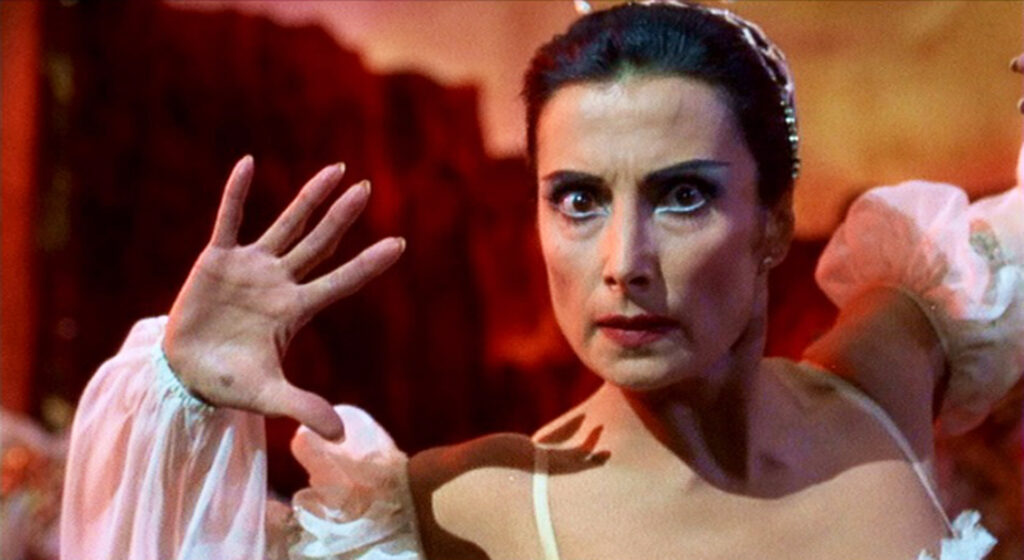
The dark eye makeup, making wings on her temples most dramatically, nicely furthers the idea of her being suspicious of him. And the culminating quality of the music nicely furthers the idea of some dramatic conclusion to our escapade now reaching its peak. (Newman and Andrews need only sit quietly; Tchaikowsky will act for them.)
Now, let us flow on, because all of the little quotations of quotation that I have mentioned so far are mere refractions of the Francesca moment, which is itself the quotation I wished to begin looking at. The earlier instant that is being quoted as this company dances onstage involved Armstrong making a clandestine escape from the West—a defection. But this was only a “defection,” as we learn; an “escape” rather than an escape, part of an American government plan to get him into the classroom with the highly secretive Prof. Lindt (Ludwig Donath) by flying him, presumably to Leipzig, from Copenhagen. The aircraft interior is shown, with Armstrong slouching in his seat and in another row a slender, elegant woman clad all in stylish black, with a furry black hat and pronounced lipstick. This one gives off all the tone of being a celebrity: by the tight packaging of her appearance, the haughtiness of her pose, the way as she looks around the aircraft space she is clearly a person used to looking at those who are looking at her. Stanley Cavell in The World Viewed: “We do not so much look at the world as look out at it, from behind the self.” Or T. S. Eliot in Burnt Norton: “the roses/Had the look of flowers that are looked at.”
She is somebody, at any rate, at least in her own estimation, and the other passengers onboard are not.
When the door is opened at the German airport, officials quickly mount the gangway in order to escort Armstrong off, but the ballerina has stepped forward, cautious as would be any celebrity to manage her celebrity status ongoingly. There are photographers at the ready. She must pose. And pose she does. Tall, arched back, proud chin, glaring twinkly eyes: star of stars. Except that the photographers are using their free hands to shoo her off so that the man who now walks past her into their limelight can be accorded the attention they came here to give him. If there is any celebrity here, is that person.
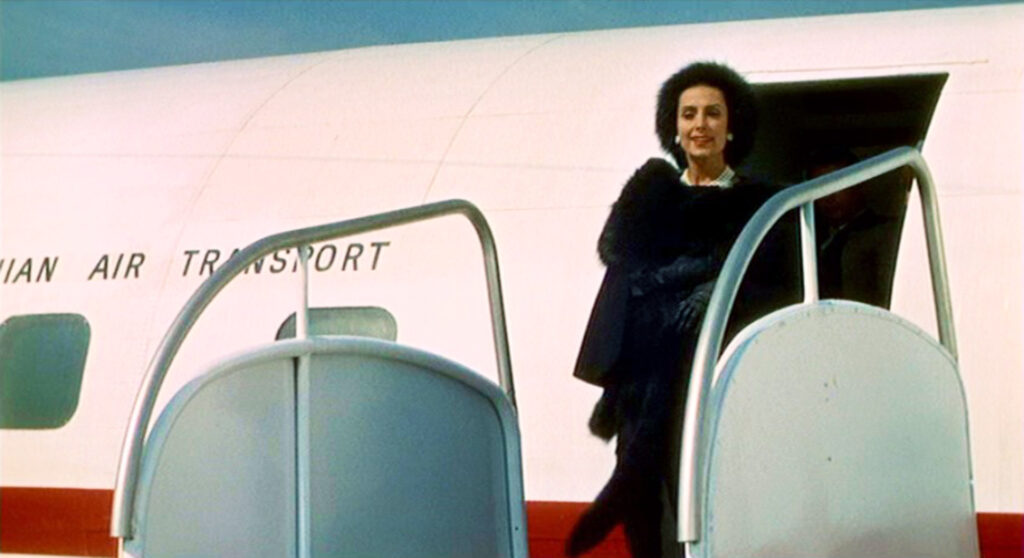
Mortifying embarrassment would describe her state of being at this instant. Passed by, neglected, stepped over, sent away. And by this lowly American! Both “You are only a human being on this aircraft, nothing special,” and “You may be special sometimes to some people but you are not the special one for us, here and now,” she seems to hear together, in one nauseatingly awkward moment. She regards Michael as a presumptuous toad, of course.
Now to the pirouettes. Tchaikowsky, romance, flamboyance. And . . . Oh yes, HIM!
And with especial vituperation here in her turns, since she is the diamond occupying the center of the stage setting. She is the reason for the company, the reason for the audience, the Reason altogether. And let it be said, she executes those pirouettes with a flash we are to presume has never been seen before, a special flash, the flash of international fame and talent of the highest order—hence this company being on tour in the first place.
The Francesca da Rimini pirouettes are a quotation, then, derived from, recalling, based upon an altogether different kind of “pirouette,” the turning of Michael Armstrong’s political affiliation and self-conception in public, before the world, as he steps off that plane. Her pirouette is no doubt the more authentic, as pirouettes go, but his is by far the more influential.
Having danced our own way through this scene, let us pause just for an instant to consider how, shooting Toumanova as he does when she is onstage, Hitchcock is quoting Alfred Hitchcock. In The Birds (1963) he originated the triple jump cut that is in use here, to show us Lydia Brenner’s (Jessica Tandy) skyrocketing awareness of horror as she looks into dead Dan Fawcett’s face and sees that the birds have pecked out his eyes. Much later, Steven Spielberg would tip is hat in E.T. the Extraterrestrial (1982), triple jump cutting into little Elliott’s panicky face as he bicycles forward with the alien in his basket and the Government agents ready to blast him with their rifles.
How tightly woven can Torn Curtain seem to us, then, when we taste the ballet scene in light of the airport scene, thinking of insult revenged, dubitable immigration status posed and then opened to query, the importance of the flash-freeze image in catching a telling gesture, and, as we may think, too, Armstrong’s visit to the East Germans as a ballet in itself, at least as tightly choreographed and as weighty as Francesca. The quoting here makes an early part of the film link to a late one, creates a circular structure, gives us the wholesome aesthetic feel of completion and release that, unfortunately, we are not going to have in the theater because Armstrong is going to be just as disruptive here, in his good-American-boy way, as Jo McKenna was in the Albert Hall in The Man Who Knew Too Much (1956) with her trained voice. The ballet will be cut off, but Armstrong and Sherman’s pas de deux will have a wholly satisfying conclusion, even in the presence, yes, of a photographer sneaking a pic and a fuming, disappointed ballerina watching from afar.
All of this is one of Hitchcock’s moves in what I have called a “double quotation.” To get to the other, we must be prepared to see how he is capable of grasping a moment in another work altogether, lifting it out surgically, and placing it in the body of his own text. Dr. Christiaan Barnard didn’t perform a successful human heart-to-heart transplantion until a year and a half after Torn Curtain came out, and this particular transplant was not by any means Hitchcock’s first. Travel to a screening facility in Los Angeles, some time after its October 1948 release in New York, and sit beside Hitchcock as he watches Michael Powell and Emeric Pressburger’s The Red Shoes. Victoria Page (Moira Shearer), the talented young dancer, has been taken into the prestigious Lermontov Company but she is a minor figure. She begs his leave formally one day—as in fact Shearer had begged leave from Ninette de Valois at the Sadler’s Wells in order to do this film—to dance Swan Lake at a little London theater.
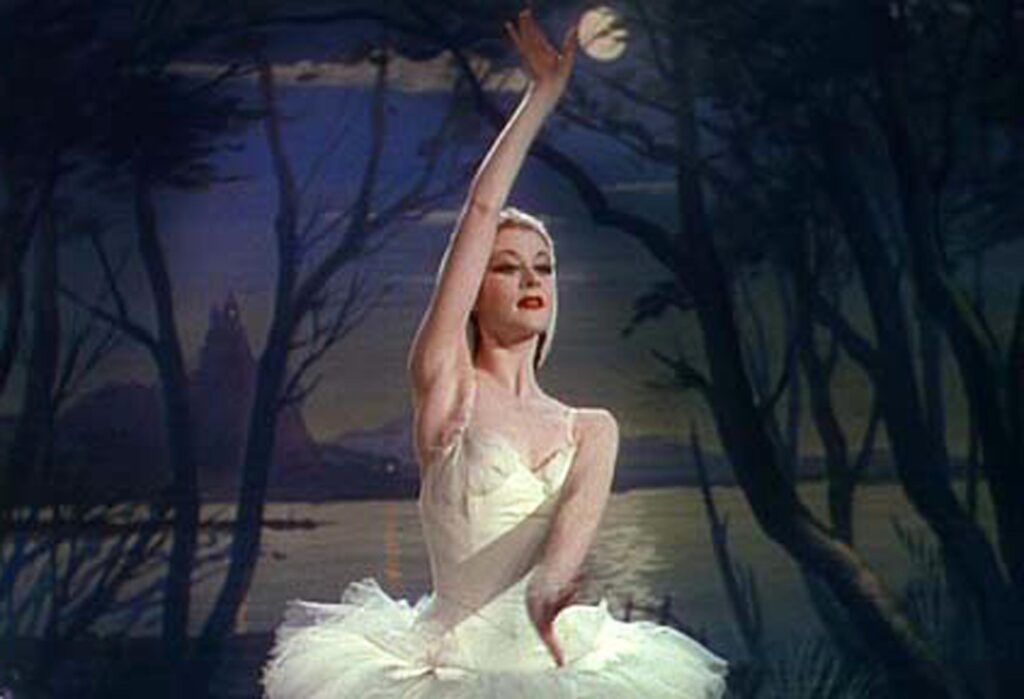
Without her being aware in the least, Lermontov (Anton Walbrook) has placed himself in her audience. We see some of the dancing: quite admirable. Vicki alone onstage (in front of, clearly, a painted backing). Jetée . . . Developée . . . Jetée . . . Developée Developée Developée . . . almost into the wings, and then, heading back across the stage far right to near left, something special:
[Long shot:] Pirouette, Pirouette. [Medium close, torso and head:] Pirouette, Pirouette. And now the camera picks up the dancer’s point of view as the world of the little theater starts to spin around her head, Around to THE AUDIENCE . . . Around to THE AUDIENCE . . . Around to THE AUDIENCE . . . Around to THE AUDIENCE (only eight rows, thirty watchers or so) . . . [Back to the dancer now, closer on her head:] Pirouette . . . Pirouette . . . Pirouette (smiling), and [Her point of view again] the spinning theater, vague, gray, blue, brilliant, until a close shot of the audience in freeze, only four rows, with Boris Lermontov affixed to her, hands folded.
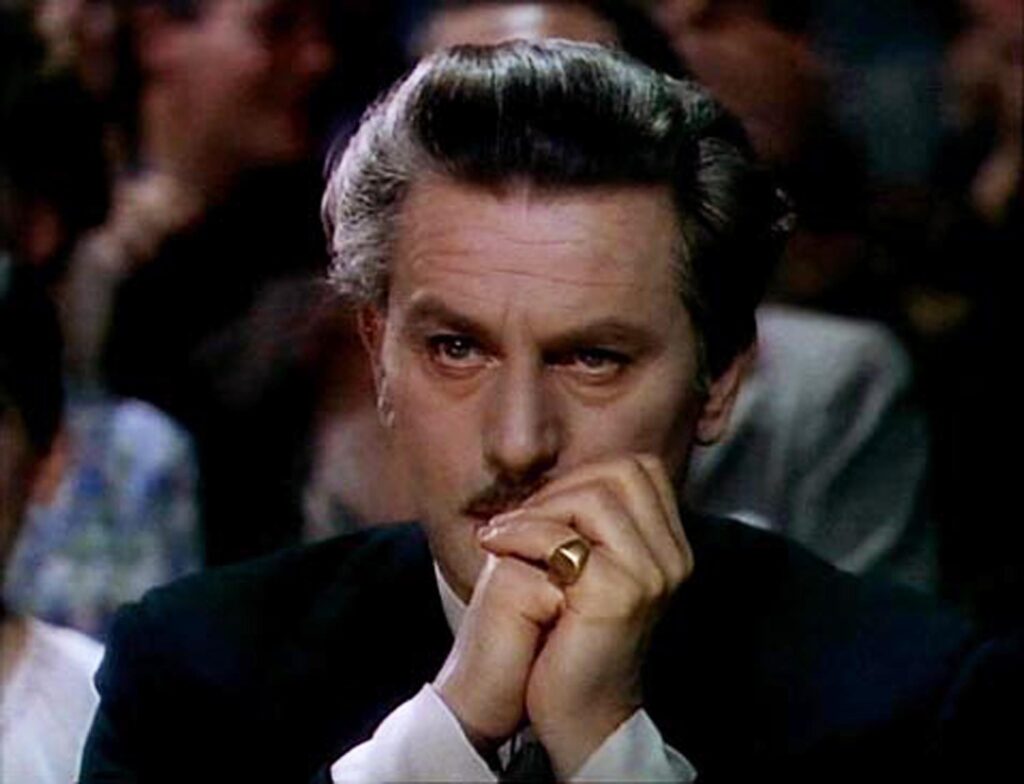
[Extreme long shot of stage] Vicki is at the left side, in a finale pose, arm up, gazing out. [Macro close shot] Lermontov’s face, hands in front of his mouth, eyes aglow. [close-up] Vicky’s face, eyes staring out to match his eyeline. Shock. Excitement. Shock. Excitement. The face pallid because whitened; the lips a vivid,
vivid red; red dots at the inner corner of the eyes and brows in black. A figure and a figurine. A woman at the same time as a goddess, descended from some unearthly climes where everything is sweetness and light.
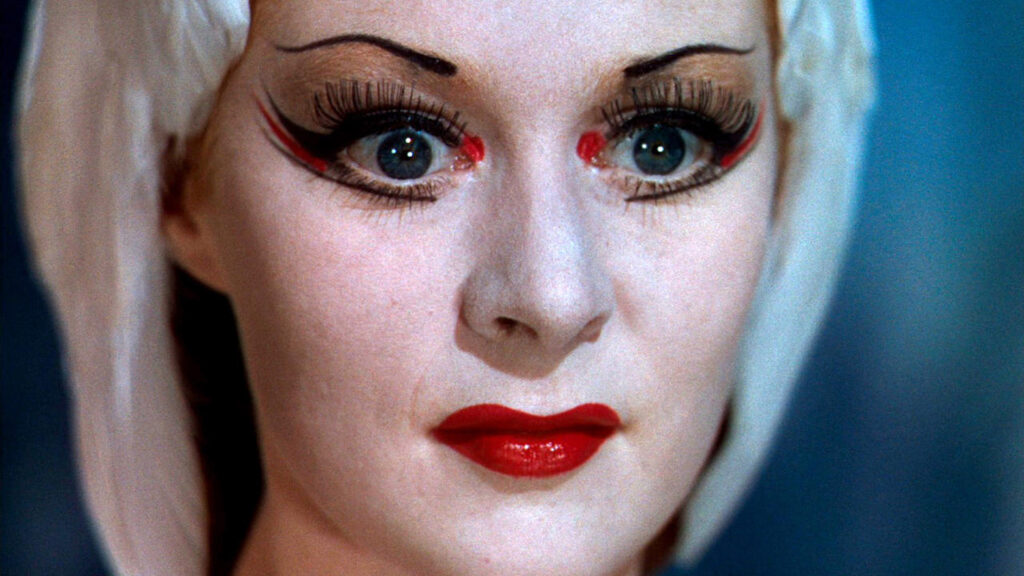
But why a ballerina at all, hence why a ballerina born from a ballerina?
And the answer, for Hitchcock, is architectonic, as we find with most events in his films. He wishes a theater pandemonium—people fleeing for their lives in the midst of a performance—and for this, something or other must be taking place onstage. A ballet gives nice musical possibilities, as well as graphic poses and an elaborate stage design, all visually appealing. The mimetic quality frees the audience from having to hear any statements and decode them. He needs the pandemonium as a way of getting Michael and Sarah out of the country. Seeing the banners of flame vibrating red and golden in the air as part of the set, Michael is inspired to call out—ironically, of course—Feuer!, and the performance is killed. Something like a setting of fire is needed, and Francesca is a convenient possibility, with dramatic music. Once we have the ballet in the theater, we must have a dancer, and once we have the dancer who recognizes Michael we have an early scene where she encounters him, unpleasantly. Then, the pirouette maneuver borrowed from Powell and Pressburger, but inverted, as a way of indicating her recognition. She must “pause to recognize” and the “pauses” are the freezes inserted in the edit. As to the parallel between Swan Lake and Francesca da Rimini, as Hitchcock, a man fond of music, would have known, the former was composed in 1875-76 (at the same time, roughly, as Francesca, and by the same composer) and premièred early in 1877. In December of 1876, a fire broke out backstage at the Brooklyn Theater in New York, killing hundreds. Fire; the stage; Francesca in a circle of Hell; Vicki Page as a Swan enflamed by artistic passion.
In tracing the leap from The Red Shoes to Torn Curtain this way, albeit cursorily, one passes across just one of the quotation maneuvers possible, since while the Swan Lake scene helps explain the complexity of the Francesca da Rimini scene what is left hanging is the ballerina on the airplane. That tiny adventure, too, must be built, and for ideal parallelism built, perhaps, from history. Let us meander back to 1953, the Vincente Minnelli spectacle The Band Wagon, considered by some the very greatest of the MGM musicals. Tony Hunter (Fred Astaire) is in the doldrums. His big-time song-and-dance career seems to have ended and he is now in oblivion, so much so that in the opening scene his top hat and cane hardly fetch a dollar at auction. His train glides into Pennsylvania Station in New York. He sits calmly in his seat, alone, while most of the passengers disembark. And then, top hat jauntily in place, he has made himself ready to hit the platform and meet New York City again, the Star Returned. Outside the door is a gaggle of press photographers, and naturally enough he pauses to let them have a shot or two, “the boys,” pleasant friendship, and let them fire some genial questions his way: standard star publicity stuff. But no: Tony is not their reason for being there today. Stepping out of the door of the adjacent car, only a foot away from him, is the internationally famous movie star Ava Gardner (played by the internationally famous movie star Ava Gardner). She and Tony are old pals, at least each recognizes the other as a compatriot in the private country of Show Business. They have a private and entirely amicable moment, and then as she goes into the business of doing the press show Tony strides his way down the platform, along the side of the gleamy train, alone, alone, and alone, singing “By Myself.”
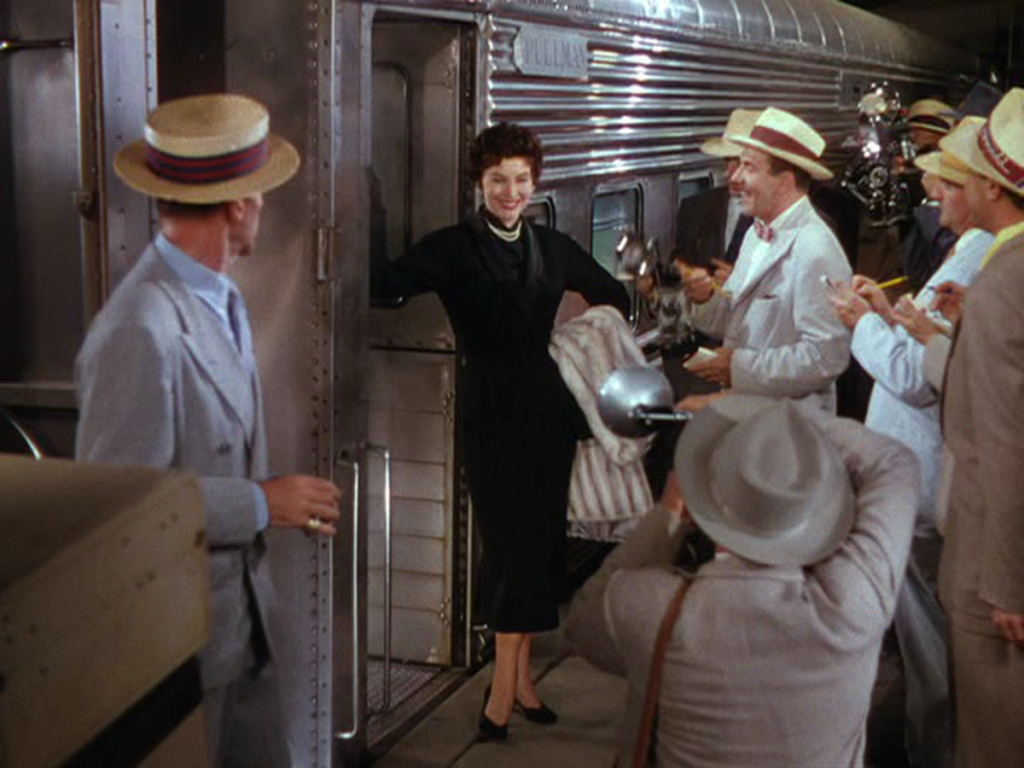
Hitchcock’s airplane exit scene is a virtual duplication of this moment in The Band Wagon, with one glaring difference: whereas Ava Gardner’s Ava Gardner is friendly, welcoming, embracing, and warm Tamara Toumanova’s ballerina is a cold-hearted shrew who would as well use a machine gun as do a pirouette. Why does Hitchcock make her so very cold? Quite beyond the standard American sterotypy of the Communist there is a reason in the architecture of the story, worked backwards from a desired conclusion to the foundation that must underpin it. She will have to be vicious from the ballet moment onward. Very vicious. When the ship on which Michael, Sarah, and the ballet company have departed Germany docks, she will be so very vicious as to guide military personnel to point their machine guns at the costume baskets, suspended by a crane, in which she is certain Michael and Sarah are hiding, and shred them with bullets. Kill, kill, kill, and overkill. With a smirk on that celebrity mouth.
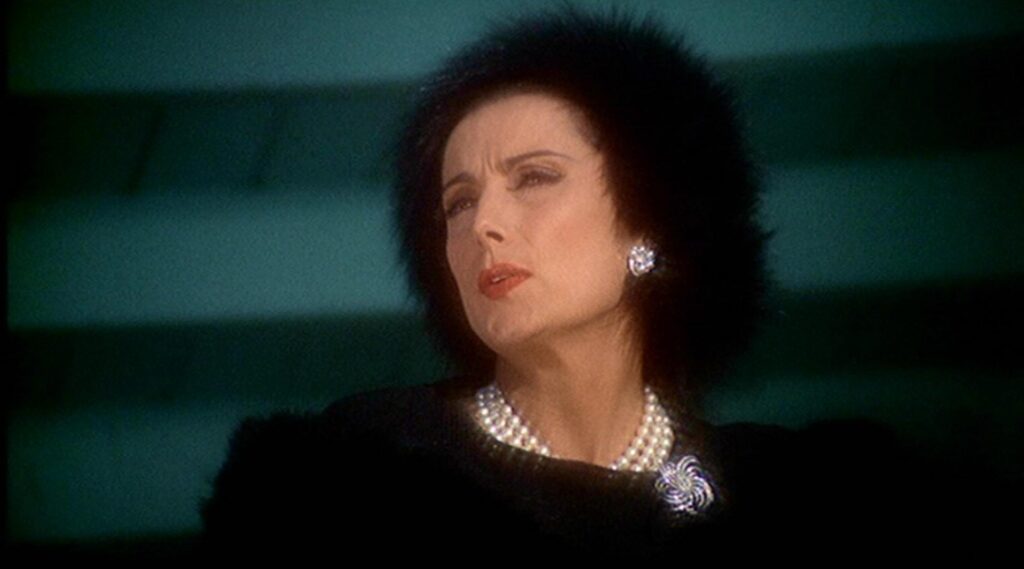
Michael and Sarah, we will be relieved to know (and this harridan outraged, seeing herself outmaneuvered once again [as in a Tom and Jerry cartoon]), are in the water and now clambering up into safe foreign territory. If he is not careful, Hitchcock knows, the ballerina’s viciousness coupled with her extreme artistic talent will come to be read as a signal that profoundly talented artists are essentially hateful and violent, which he does not believe or wish his viewers to believe. She must, therefore, have some personal reason to want to “get” Michael Armstrong—something affecting not only her Communist loyalty but also her ego—and therefore the airport snubbing, a perfect pretext.
The Band Wagon train scene thus leads to a quotation in the Torn Curtain airport scene, and the Red Shoes performance scene leads to a quotation in the Torn Curtain theater. The arrangement of the multiple balancings is tidy, crisp, telling, beautiful to look at, even, in a way, funny. When we know about it, our pleasure can be magnified.
But let me address two rather cynical questions that are likely to arise when quotation of the sort I describe here is detected, or when someone in the course of a discussion takes the trouble to point something like this out. First, what is the purpose? Can the quoter have had something in mind, in going out of his way to find what he wants to say in the words of someone else—in film terms, to find his image in the image of another film? Or in the sound, as with François Truffaut using Bernard Herrmann’s sound cues from Marnie (1964) for his La mariée était en noir (1968). Why, in short, not speak for oneself? This kind of question can lead directly to wondering about themes, angles, modes of address, moral lessons, the whole panoply of structural artifacts that compose what we call a film’s meaning. How is it that an artist who means to express one thing should find it necessary to obtain help from another artist who made a work that, as later appears, could be helpful? In terms of Torn Curtain, why not just have a ballet of any kind, with the prima ballerina preparing herself before the curtain goes up, stretching backstage, and, with the kind of excited tension such an artiste would have, peeking through a peephole in the curtain (just as Hitchcock has Toumanova do) and . . . presto! . . . discover the lurker in the audience. Why are the pirouettes needed, and if for some acceleration of excitement in the viewer they are felt to be necessary, why mirror The Red Shoes? After all, “Here is another lovely film about ballet” doesn’t help the viewer see Francesca da Rimini, in fact if stated too boldly it actually diminishes the gaze.
The second question is subtler, and more pernicious in its way. Here it is: does the filmmaker honestly expect that his audience will grasp the quotation for what it is, given that the film medium, unlike printed text, has no equivalent of the quotation mark? Are we to know the history of cinema, then, before coming to Torn Curtain, and even if we do know something of what has gone before onscreen are we meant, absorbed in Hitchcock’s action, to draw ourselves out into the vestibule of memory and start making connections? Is the film, then, actually exclusively oriented to people who can “read between the lines,” as it were? Is Hitchcock a snob?
First, the snobbery, which could surely be salient, even obnoxious, if it delved into arcane multilinguistic nuances in a context of serious dramatic climax, where a viewer’s failure to grasp the full array of relevant details would impair her ability to find release with the film. A celebrated raconteur at Oxford beguiles his listeners while they sip delicious champagne with a long and complicated story building to a phenomenal climax, which he delivers in obscure Provençal French, or in classical Greek—-that kind of thing. Very very very very profound. Too profound. Hitchcock is never snobbish in the least, and never makes any moment of quotation, which is also a key moment in his film, dependent upon our recognition of the quoting or our sensitive interpretation of its content and intended possible relation at present. All these are potential gifts, filigrees, touches that undoubtedly add resonance, but not a resonance upon which the turn of the film must work. More important than the ballerina’s pirouettes, for instance, are the fake stagey flames that Armstrong sees—the ballet’s set design—and that inspire him to call out the single word that explodes the event into chaos. He can see the flames and yell “Feuer!” with or without the pirouettes. So, although they add to the flavoring of our enjoyment if we know about them, still, they do not affect the forward action, ironically, since they are so elegantly and powerfully composed of forward action themselves.
And then, purpose. If they are not part of what is required, why are they there? Is the filmmaker feeling some obligation to tip his hat to colleagues whose films came before? Or, wanting to have a particular set-up, is he in fact at a complete loss as to how he might proceed without having the crutch of a previous scene to build his form upon? And the answer here, I think, is both simple and truly inspiring. Hitchcock was as much a lover of cinema as those who come to watch his films. The films he saw and loved, especially the moments in them that particularly touched him, he cherished, and with a living passion. These filmic pieces—“pieces of time,” Peter Bogdanovich has his mogul call them in Nickelodeon (1976)—are not only in his past, they are in him always as he works, part of his language, which is to say, part of the spirit he inspires when he films. My own belief about Hitchcock is that there would have been no other way for him to make the scenes I have discussed, and that in fact, he was only the playing out his intent, morsel by morsel, view by view, using all of the resources in the gallery of his past. He was working. I am the one, poor wretch, finding links, calling up the word “quotation” when what is in front of me is pure cinema.

Murray Pomerance is an independent scholar living in Toronto. He is the author, most recently, of The Film Cheat: Screen Artifice and Viewing Pleasure; Grammatical Dreams; Virtuoso: Film Performance and the Actor’s Magic; A Dream of Hitchcock; and Cinema, If You Please: The Memory of Taste, the Taste of Memory, as well as of the BFI Film Classics, Marnie and The Man Who Knew Too Much. His book A Voyage with Hitchcock and his book Color It True: Impressions of Cinema are both forthcoming.
ORCID : 0000-0002-6233-4503
Murray Pomerance
